The Ultimate Guide to Glacier National Park
Known as the “Crown of the Continent,” this Montana park contains 200 waterfalls, 700 lakes, and 700 miles of trails. Also: you can walk on a glacier.
Heading out the door? Read this article on the Outside app available now on iOS devices for members! Download the app.
While other kids were meeting Mickey Mouse at Disneyland, I grew up going to Glacier National Park and learning the difference between black bear scat and grizzly scat. My dad always joked that grizzly scat contains hikers’ bear bells. It’s how I learned to remember which bears were carnivores. For us Montanans, visiting Glacier, the holy grail of God’s country, was a given, a rite of passage. But for most of the national park’s annual visitors—3.1 million last year—Glacier is one for the bucket list.

If you’re wondering what’s so special about Glacier, let’s start by singing the praises of scarcity. Not many places are left where you can see, let alone walk on, active glaciers. Still, the park is more than massive bodies of moving ice. It’s the “Crown of the Continent”—so named because its one million acres are part of the largest intact ecosystem in the country. As kids, during class field trips to Glacier from Lewistown (my hometown in the center of the state), we studied everything from edible plants to aquatic insects. Standing on our tiptoes in the visitor center, we’d reach across a raised-relief map to touch Glacier’s 8,020-foot Triple Divide Peak. The mountain is the only place in the country where a raindrop can land and wind up in one of three places: the Pacific Ocean, the Atlantic Ocean, or Hudson Bay.
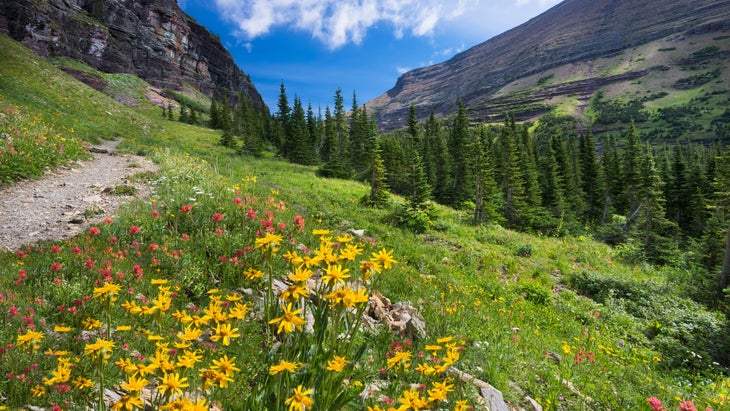
In 1999, my family attended a Jack Gladstone concert at Glacier’s Lake McDonald Lodge and bought his cassette tape. His “Hudson Bay Blues,” a ballad about what it was like for Natives when the white man introduced the concept of shopping, was from then on our soundtrack for driving Going-to-the-Sun Road, the park’s main artery. Known as “Montana’s troubadour,” Gladstone is a member of the Blackfeet Nation—the state’s largest tribe and Glacier’s original inhabitants from long before William Taft declared the place America’s tenth national park in 1910. Fortunately, the tribe is still very active within the park: members lead tours and host info-rich presentations.
Whether you come for glaciers, grizzlies (in addition to bells, bring bear spray and know how to use it), or Jack Gladstone, you’ll be in a near constant state of awe here. In his book Our National Parks, the great naturalist John Muir goes so far as to say everyone should spend at least a month in Glacier. “The time will not be taken from the sum of your life,” he promises. “Instead of shortening, it will indefinitely lengthen it and make you truly immortal.”
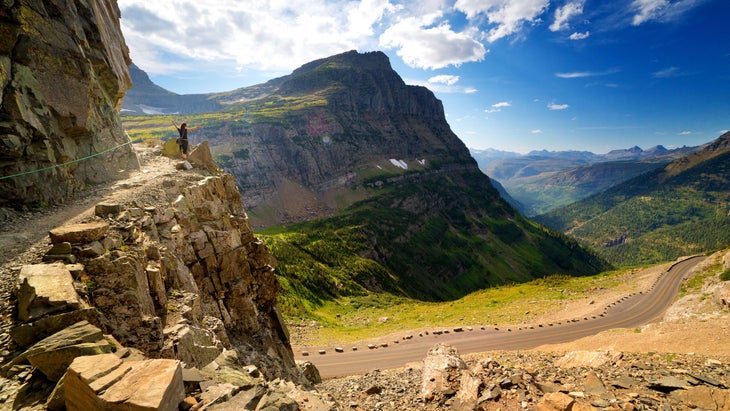
What You Need to Know Before Visiting Glacier National Park
Cash isn’t king
In fact, it’s not accepted in the park, so plan on using your debit or credit card. You can also purchase passes in advance online. Just make sure to print them or download them onto your phone before arriving at the park (where cell service is sketchy at best). Passes, good for seven days, cost $15 if you’re on foot or bike, $20 for motorcycles, and $25 for vehicles. Rates increase by $5 to $10 May through October. Since the park is open 24/7, every day of the year, there may be no one operating the entrance kiosk; in that case, follow posted instructions for self-payment.
Beauty begets bumper-to-bumper traffic
Going-to-the-Sun Road in the summer can back up like an L.A. freeway. For that reason, vehicle reservations are now required late May through mid September to access both the road and the North Fork, the northwest corner of the park, where the roads are unpaved and services are few. To make a reservation, call 877-444-6777 or visit Recreation.gov (and be prepared to pay a $2 processing fee). If you have reservations at lodging within the park (including campgrounds), or have booked a tour, that counts as your vehicle reservation.
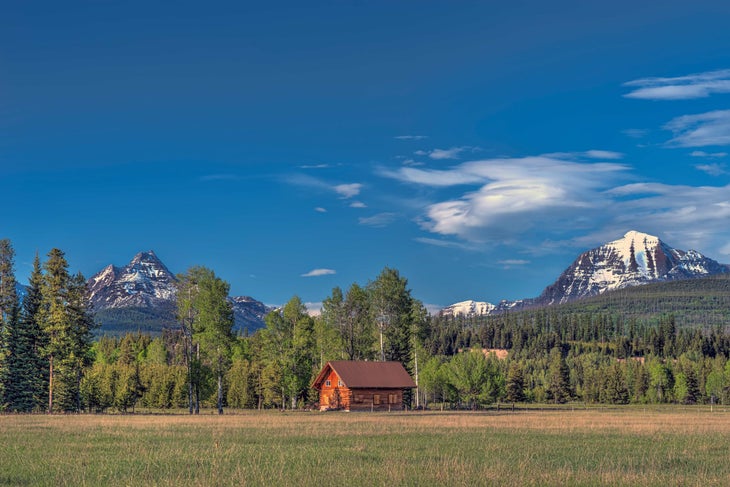
Say goodbye to bars (of service) and gas
While I can usually get a signal in the area from West Glacier to Apgar Village and near St. Mary, most of the park is a dead zone. There are also no gas stations, so fill up in advance in the popular western and eastern entrance towns of West Glacier or St. Mary, respectively. Better yet, ditch the car and take advantage of the free shuttle service, which typically runs July 1 through Labor Day, with limited service through September. The shuttle vehicles are either Sprinter vans or 28-passenger buses, most equipped with bike racks. Additionally, special shuttles for hikers and bikers run every weekend from May through June.
Pets aren’t people, too
Unfortunately, Glacier isn’t very pet-friendly. No dogs are allowed anywhere outside of vehicles, except parking lots, developed areas, and the Apgar bike path.
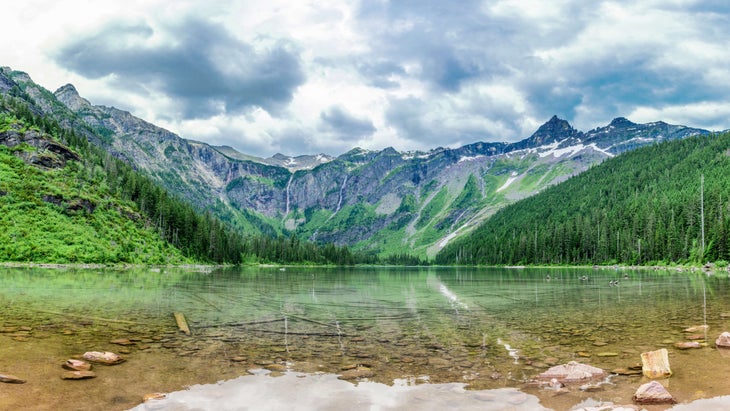
How to Get to Glacier National Park
At 1,583 square miles (a size that could swallow Rhode Island), Glacier has five entrances: two on the west and three on the east. You reach West Glacier, the most popular, by taking Highway 2 east of Kalispell for 32 miles. Once you are inside the park, continue 27 miles north on North Fork Road to the Pole Bridge entrance. On the east side of the park, most visitors enter at St. Mary or the Two Medicine entrance, both approximately a (rather flat and desolate) 150-mile drive northwest from Great Falls on Highway 89. To access the more remote Many Glacier entrance—where I once saw three bears on one hike—head to St. Mary, continue north, outside the park, on Highway 89 for another nine miles, then turn left and take Route 3 for eight miles.
Glacier’s nearest airport is Glacier Park International Airport in Kalispell, about a 30-minute drive from West Glacier. Don’t be fooled by the word international; it’s a tiny facility, serviced by few flights. For more options and cheaper fares, consider flying into Missoula International Airport, a 2-hour drive south of Kalispell. Another possibility is Great Falls International Airport, a 2.5-hour drive from St. Mary.
The park is also accessible by rail. Simply take Amtrak’s Empire Builder train, which runs daily between Chicago and Seattle or Portland, the Pacific Northwest. The train stops in both East Glacier and West Glacier. While rental cars are available in East Glacier, they go fast, so reserve one in advance. West Glacier has no rental cars; however, Xanterra operates a seasonal shuttle connecting the train station to Lake McDonald Lodge, where you can catch the Going-to-the-Sun Road shuttle.
The Best Time of the Year to Visit Glacier National Park
Winter
Winter in Montana comes early. The higher-elevation roads in Glacier typically close for the season in October. Only the 11-mile stretch of Going-to-the-Sun Road between West Glacier and Lake McDonald is open year-round. Most park services, including visitor centers and lodges, also shut down. That said, in winter you feel like you have the park to yourself.
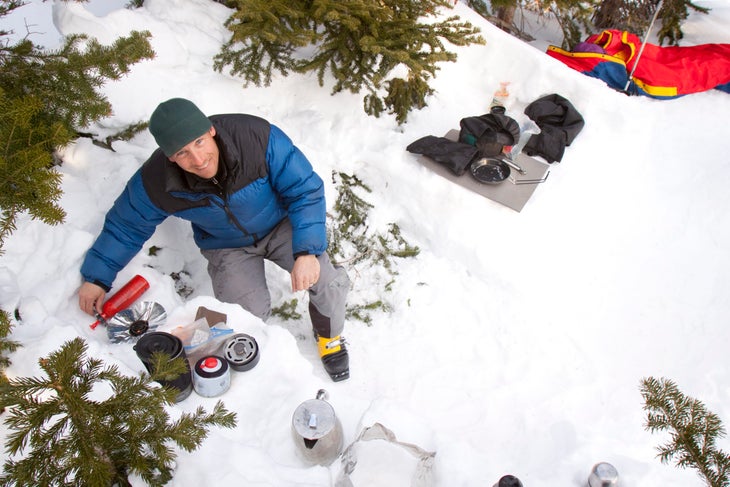
Spring
Spring in Montana comes late. Most park services remain closed until the end of May. It’s also common to receive winter storm warnings well past winter (welcome to Montana). But with spring runoff, these months can be the best for photographing the park’s 200 waterfalls. Just don’t be surprised if you get stuck behind a snowplow. In March the Park Service begins clearing the roads—a Herculean task that can take three months.
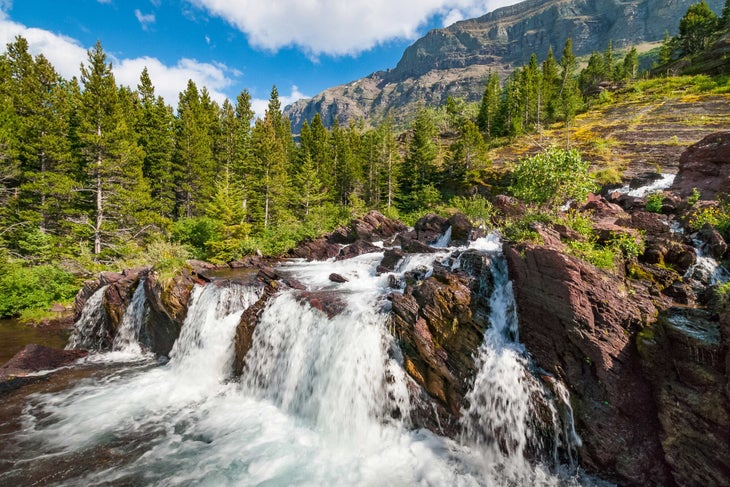
Summer
Even if you have to circle the visitor center parking lot five times before finding a spot, it’s hard to hate on anything in July and August in Glacier. Going-to-the-Sun Road is completely plowed, and you can finally hike without postholing. All accommodations—including backcountry chalets—are open, bears are out of hibernation, and wildflowers are in full bloom. Pro tip: book rooms as early as you can. Most sell out months in advance.
Fall
By early October, the park’s lower elevations are awash in a sea of yellow. While park services and roads start to close in September, there’s still a healthy population of hikers. August can see as many as 800,000 visitors, September welcomes about half that, and by October, the number dwindles to fewer than 100,000. Whether you’re bagging a peak or chasing that Going-to-the-Sun Road Strava KOM, it’s important to have bear spray on your hip (and again, practice with it). The park’s 900 bears—an estimated 300 grizzlies and 600 black bears—will be busy foraging for winter sustenance.
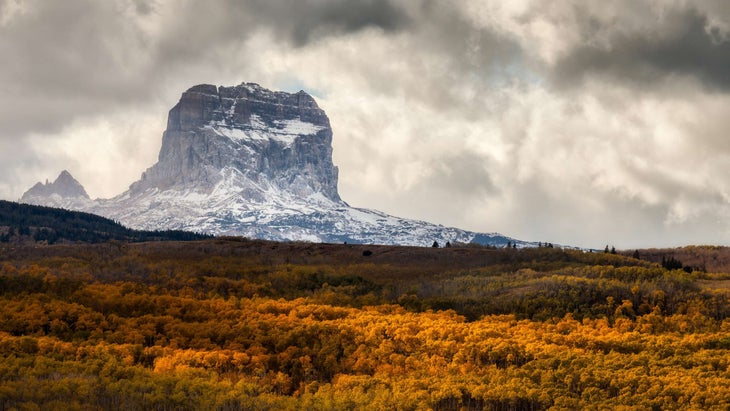
Where to Stay In or Near Glacier National Park
Hotels
Most in-park accommodations, operated by Glacier’s concessionaire, Xanterra, open in May and close by September. Built of natural materials like wood and stone, they’re your quintessential examples of historic “parkitecture.” Think two-star rustic digs, and forget about creature comforts like Wi-Fi, TV, and A/C.
The park’s most sought-after rooms are at Many Glacier Hotel (from $235), a five-story Swiss-inspired resort hugging the shores of Swiftcurrent Lake, and Lake McDonald Lodge (from $127), overlooking the park’s largest body of water. Both were built between 1913 and 1915.
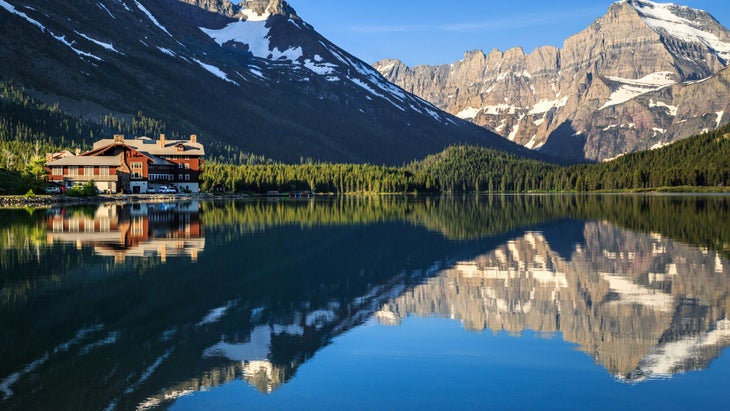
Your pull-up, park-in-front-of-your-room options include Rising Sun Motor Inn and Cabins (from $235), the St. Mary area, and Swiftcurrent Motor Inn and Cabins (from $137), Apgar. When I want to whip up my own meals, I crash at the Village Inn at Apgar (from $215), where units include small kitchens outfitted with the basics, including a microwave, coffee maker, stove, oven, and fridge.
The only Xanterra accommodation open year-round is Cedar Creek Lodge (from $200) in Columbia Falls, about a 15-minute drive from West Glacier. Admittedly, I stay here for the amenities: an indoor pool, a 24/7 fitness center, and free continental breakfast. Sometimes I base out of Missoula, and then I hole up at the new AC Hotel by Marriott (from $280). Its location is ideal for exploring the mountain-meets-college town, which boasts Montana’s best river surfing. The 2.5-hour drive from Missoula to Glacier cuts through lake country and is one of the most scenic drives in the state.
Chalets
Hands down, the most charming accommodations in the park are the historic chalets that look imported from Switzerland. You have to hike into Granite Park (from $124) and Sperry (from $253), but that’s half the fun. The hard part is scoring a spot (reservation tabs on the above sites are Granite Park, Sperry). I’ve had friends try for years and still never get reservations.
Camping
Approximately 70 percent of Glacier’s wilderness camping sites go to those with advance permits/reservations. These permits are available at Pay.gov and cost $40 (with additional fees per person per night). Allow at least a month for your permit application to be processed.
Walk-in permits ($7 per person per night) are available at the Apgar Backcountry Permit Center, St. Mary Visitor Center, Many Glacier Ranger Station, Two Medicine Ranger Station, and Polebridge Ranger Station. Winter wilderness-camping permits, good November through April (when the grizzlies are, hopefully, deep in REM sleep), are free.

In addition to wilderness camping, Glacier has 13 campgrounds ($10 to $23 per night). Three of them—Fish Creek, Many Glacier, and St. Mary—require reservations. Apgar and Sprague Creek only require reservations in the summer. All reservations can be made via Recreation.gov.
First-come, first-served is the name of the game at all other campgrounds. Most close in the winter, but a few stay open for primitive camping. None of Glacier’s campgrounds have electrical hookups, and most lack potable water or firewood for sale. Pets are allowed but must be leashed.
The Best Adventures in Glacier National Park
Glacier Viewing
Glacier is currently home to 25 active glaciers. Scientists estimate they could disappear, courtesy of climate change, as early as 2030. As a kid, I was disappointed to learn that most of them can’t be seen from the car. The exceptions are Jackson Glacier, which you can view from the overlook on the east side of Going-to-the-Sun Road, and Salamander Glacier, visible from the road after passing the Many Glacier entrance booth. Others, including the park’s largest, Blackfoot Glacier, and one of its most photographed, Grinnell Glacier, require boots on the ground. And bring binoculars—unless you’re a bushwhacking badass, some glaciers can only be viewed from afar.
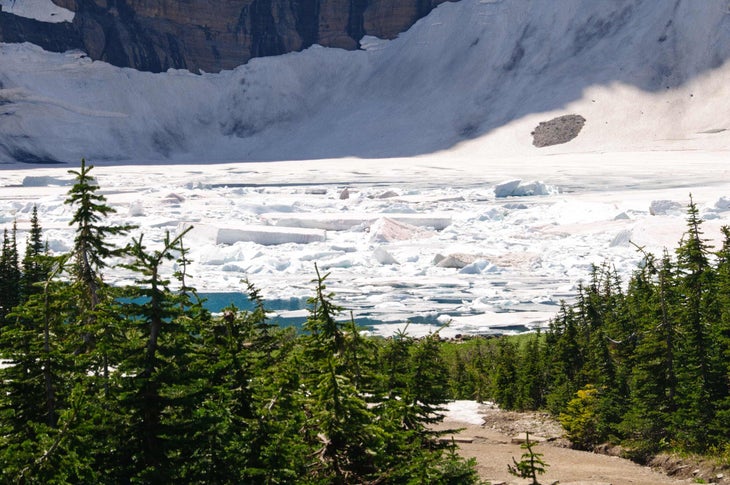
Hiking Trails
Glacier is God’s gift to hikers. The park boasts more than 700 miles of marked trails, many remote enough that you’ll encounter more fauna than fellow Homo sapiens. Again, packing bear spray is a must. It’s also important to check trail-status reports. Outside of July and August, many trails, especially at higher elevations, are hidden by snow. Footbridges aren’t installed until late May.
The 18 trails in the Lake McDonald area include the Trail of Cedars, one of two wheelchair-accessible trails in the park, a 1.4-mile boardwalk loop that takes you through Glacier’s only such forest. On the far end of the spectrum is Mount Brown Lookout, a 10.4-mile out-and-back StairMaster of a trek, ascending more than 4,300 feet.
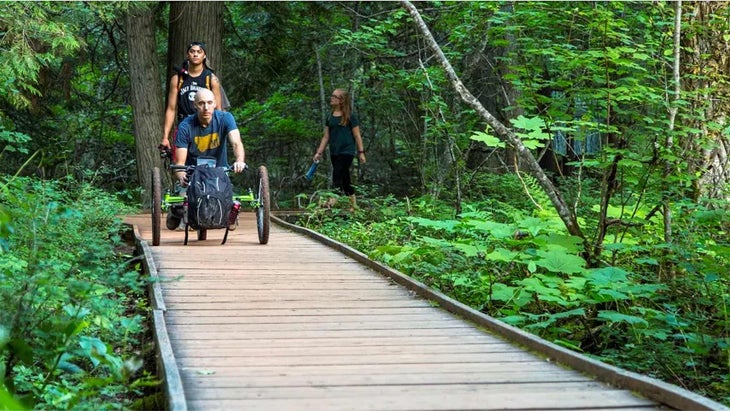
The area called Many Glacier, basically a mini park within the park, has 12 trailheads, including Swiftcurrent Pass, Iceberg Lake, and Grinnell Glacier—a 10.6-mile out-and-back culminating at a glacier you can walk across. Since much of the hike is exposed, wear plenty of sun protection.
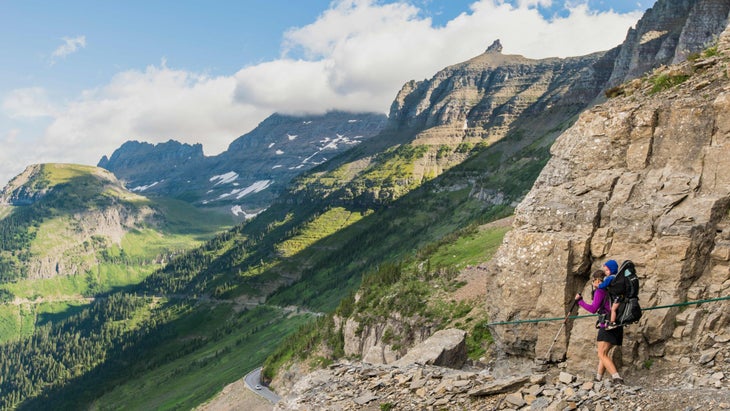
The 15 trails at St. Mary’s include Otokomi Lake, an 11-mile round-trip hike peppered with waterfalls, and Siyeh Pass, a strenuous 9.7-mile point-to-point. The reward for all those switchbacks? Commanding views. Topping out at 8,100 feet, Siyeh Pass is one of the highest trails maintained by the park. The more remote North Fork and Goat Haunt sections have 15 trails, ranging from those on rolling hills to the arduous Numa Lookout, an 11.6-mile out-and-back ending at a fire tower with vistas of Bowman Lake some 3,000 feet below.
Two Medicine Valley has another 12 trails; favorites in this area are Dawson Pass and Pitamakan Pass, which can be combined for a challenging 18-mile loop that crosses the Continental Divide twice. (Pro tip: shave off about three miles by taking the concession boat at South Shore Trailhead.)
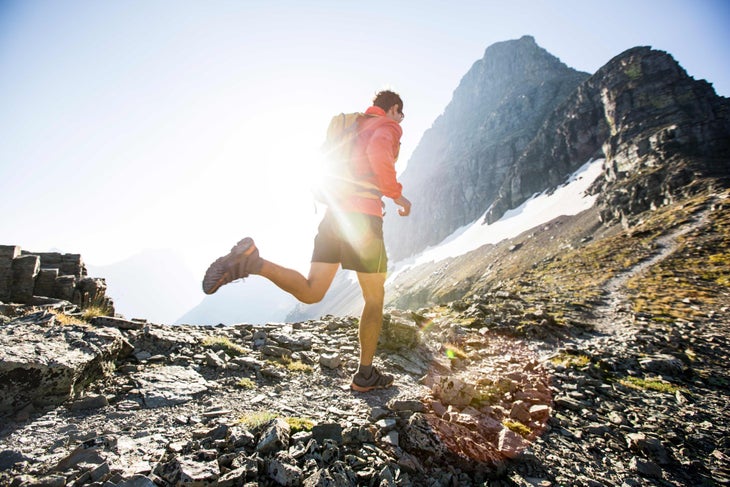
For guided hikes, porter services, and van support, contact Glacier Guides.
Biking Routes
What Glacier lacks in off-road mountain biking (spoiler alert: there is none), it more than makes up for in road biking. In my honest opinion, Going-to-the-Sun Road should be on every serious roadie’s short list. I usually start at Lake McDonald Lodge, where it’s about 21 miles and 3,500 feet of climbing to Logan Pass. Worried about the pain of that much elevation gain? The alpine vistas on either side are a great distraction. Note: between mid-June and Labor Day, portions of Going-to-the-Sun Road are closed to bikes between 11 A.M. and 4 P.M. And another note: packing warm, waterproof layers for the descent is key; every year rangers rescue cyclists suffering from hypothermia.
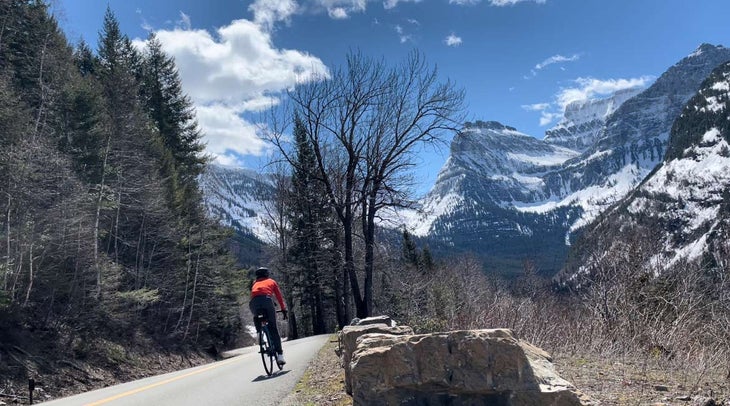
Bicycles are also allowed on the park’s unpaved roads and multi-use paths. Rentals are available at Glacier Guides in West Glacier and at Glacier Outfitters in Apgar Village. Expect to pay at least $50 for a hybrid and $130 for an e-bike. They go fast—literally—so reserve your ride in advance.
Rafting Trips
Between the Flathead River’s North and Middle Forks, which form the park’s western and southwestern boundaries, you can enjoy everything from scenic floats through glacier-carved valleys to Class III rapids in winding canyons. The more remote North Fork, beginning in British Columbia, tends to be calmer. If whitewater floats your boat, opt for the Middle Fork.
Outfitters offering half-, full-, and multiday tours include Glacier Guides and Montana Raft Company, Glacier Raft Company, Great Northern Resort, and Wild River Adventures, all located in West Glacier. Rafting season typically starts in May and runs through October.
Boating and Paddling
With more than 700 lakes, Glacier is a boater’s promised land. The crystal clear waters rarely get hotter than 50 degrees Fahrenheit, resulting in minimal vegetation and maximum visibility. Lakes near active glaciers even tend to be turquoise. At ten miles long and 464 feet deep, Glacier’s largest body of water, Lake McDonald, is its unofficial boating hub.
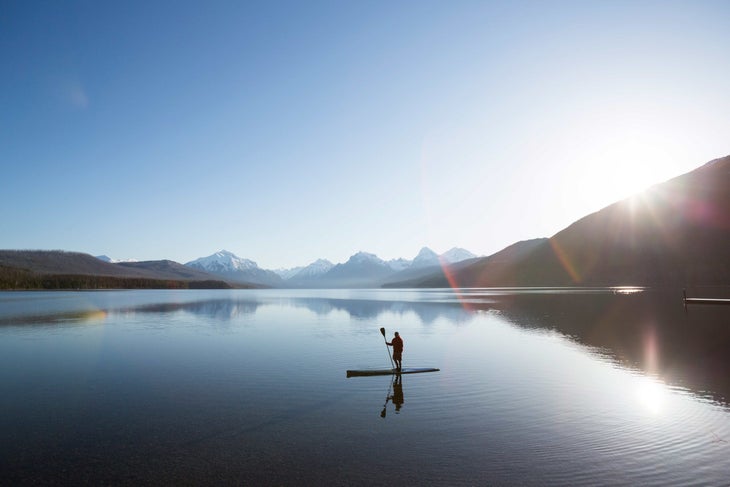
To prevent bringing in aquatic invasive species (AIS), all watercraft must pass inspection. There are inspection stations at Lake McDonald; Polebridge Ranger Station; the Many Glacier Area ranger station; and through the park’s AIS partners beforehand. See information on inspection and stations here.
Boating is allowed at Lake McDonald, Kintla Lake, Bowman Lake, Two Medicine Lake, St. Mary Lake, and Sherburne and Swiftcurrent Lakes in Many Glacier. The season varies by lake, with most opening in May and closing in late September. Didn’t BYOB? That’s OK. Rentals are available at Glacier Park Boat Company in Apgar Village.
Glacier also offers guided boat tours. In Many Glacier, you can cross Swiftcurrent Lake on the historic Chief Two Guns, and the adventure continues on Lake Josephine aboard the Morning Eagle. At St. Mary, you may sail on Little Chief or Joy II past Wild Goose Island to Baring Falls. To experience the oldest wooden boats in the park, cruise Lake McDonald on the 70-passenger DeSmet or Two Medicine on the 49-passenger Sinopah. Both vessels, built in 1930 and 1926, are on the National Register of Historic Places.
Snow Sports
While Glacier bans snowmobile use, it welcomes all winter warriors on skis, splitboards, and snowshoes. Rentals are available at Glacier Nordic Club and Glacier Cyclery and Nordic in Whitefish. Before sharpening those Salomons, however, always check here for trail conditions and the Flathead Avalanche Center for avalanche updates. There tends to be more snow on the west side of Glacier, as the east side receives warm Chinook winds. Average snowfall at park headquarters in West Glacier is 157 inches.
While most ski routes are unmarked, trail maps can be found online. The most popular place for winter sports is Upper Lake McDonald. Park at Lake McDonald Lodge for access to McDonald Falls, a four-mile round trip with waterfall views; Sacred Dancing Cascade, a 5.3-mile round trip with equally impressive waterfall sights; and Avalanche Lake, an 11.6-mile round trip with a frozen lake to look forward to (this last one is best left to intermediate and expert skiers).

There are also several trails near Polebridge, following unplowed roads from the starting point of the ranger station, and near Apgar, beginning at the horse barn. Not a fan of the repetition of out-and-backs? Try the 11.5-mile McGee Meadow Loop (and go counterclockwise if you want to avoid a steep uphill).
On the east side of the park, most of the action is at Autumn Creek, a challenging six-mile round trip beginning at the summit of Marias Pass. For rolling terrain with lake views, check out St. Mary’s three-mile Beaver Pond Loop or eight-mile Red Eagle Lake Trail.
Fishing
With more than 1,606 miles of waterways, Glacier attracts anglers like a lipless crank attracts a pike. You don’t need a fishing license—just knowledge of which species are native. For the most part, it’s catch and release for all native species, including westslope cutthroat trout, bull trout, and northern pike. There’s no daily limit (catch or possession) for non-native fish, which include rainbow trout, Yellowstone cutthroat trout, and brook trout.
The rule is one rod per person, hook and line only, and no live bait. While lake fishing is allowed year-round, the season for most rivers and streams runs from May through November. Winter ice fishing is allowed; however, you’ll get a hefty fine if you use a power auger. Rod rentals are available at Glacier Outfitters in Apgar Village and Glacier Outdoor Center in West Glacier.
Guided Tours
Glacier’s sheer size—it’s larger than Canyonlands, Grand Teton, and Rocky Mountain National parks combined—lends itself nicely to guided tours. The park’s iconic red vintage buses, nicknamed the Rubies of the Rockies, date back to the 1930s. In fact, they’re considered the world’s oldest touring fleet of vehicles. Expect to pay between $50 for a three-hour tour and $112 for an eight-hour tour. Most tours start in May or June and run through September.
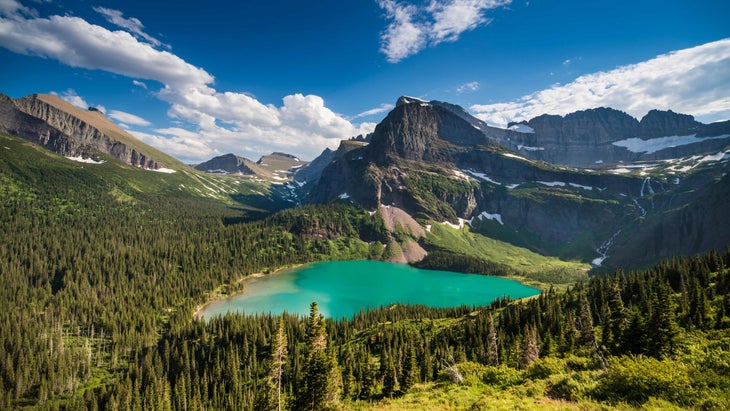
Sun Tours, operating May through October, offers bus tours driven by local Blackfeet guides. The fleet of buses is owned by a married couple, Ed and Toni DesRosier, who are members of the Blackfeet and Assiniboine Sioux Nations. Half-day tours start at $80, and full-day tours start at $130.
Another great way to see the park is from the saddle. Guided horseback adventures run seasonally in Many Glacier and at Lake McDonald and Apgar. One-hour tours with Swan Mountain Outfitters, a family-owned business based in West Glacier, start at $75.
Educational Programs
In summer, rangers lead programs every day. Most are free, with the exception of some of the Native America Speaks events, the National Park Service’s longest-running Indigenous-speaker series. Adult tickets for these events are $6. Local tribe members, like Jack Gladstone, host these popular evening presentations and programs.
Glacier Institute, where I attended camp as a kid, is a nonprofit specializing in field-based learning. Sign up for courses and classes focusing on everything from birds of prey to landscape photography.
The Best Places to Eat and Drink Near Glacier National Park
I’m not going to sugarcoat it; meal options within the park are limited. On the plus side, the dress code is always hiker casual. At Lake McDonald Lodge you’ll find Jammer Joe’s Grill and Pizzeria, Lucke’s Lounge, and Russell’s Fireside Dining Room. For views, it’s hard to top the Ptarmigan Dining Room in Many Glacier Hotel, and if you want more casual fare, try the hotel’s Swiss Lounge or Heidi’s Snack Shop and Espresso Stand. Or head just down the road to ’Nells, whose boxed lunches are a big hit with hikers. In St. Mary, it’s either starve or settle for Two Dog Flats Grill, which gets points simply for being open.
Summit Mountain Lodge and Steakhouse, with beef so local you probably drove by pastures where that animal grazed, has East Glacier’s best wine list. Dining on the deck? Don’t be surprised if you see a moose. And order the famous huckleberry cheesecake before it sells out.
Dining in West Glacier doesn’t get better than the Belton Grill Dining Room and Tap Room, where locals celebrate special occasions and the ambiance is as memorable as the menu. Sip craft cocktails by the 100-year-old fireplace or enjoy a flight of craft brews on the elevated deck. Hangry after hiking? Try the bison meatloaf or elk meatballs. Not a carnivore? Go for the red curry.
For a quick bite in West Glacier, trust the Wandering Gringo. This roadside Tex-Mex trailer is where your fishing and rafting guides refuel with massive burritos that make Chipotle seem like child’s play.
If You Have Time for a Detour
In Glacier’s neighbor to the north, Waterton Lakes National Park, where I learned to ride a big-girl bike, Alberta’s rolling prairie meets the stunning Canadian Rockies.
The 195-square-mile park, which combined with Glacier formed the world’s first International Peace Park in 1932, is home to more than 60 species of mammals. If you don’t see a bear or goat in Glacier, there’s a good chance you’ll see it here. Waterton is just an hour’s drive north of St. Mary, with the border crossing at Carway or Chief Mountain. I’ve always called Waterton a junior-varsity version of Banff (it’s beautiful, but Banff is beautiful on steroids). Banff is another 3.5-hour drive farther north. If you have time, visit both.
Flathead Lake is also worth the gas money. The largest freshwater lake west of the Mississippi, it’s where I learned that scuba diving in Montana was actually a thing. Basically, anything you can do on a huge body of water—plus hiking on an island home to herds of wild horses—you can do on Flathead Lake. Every year my family vacations here, and I eat so many Flathead cherries that my fingers are stained pink for weeks. (I swear the 27-mile-long lake has as many orchards as boating ramps.) The lake’s northern shore is just 40 miles southeast of West Glacier.
How to Be a Conscious Visitor
As a result of the receding glaciers, it’s impossible to visit their namesake park without being conscious of climate change. Since automobile emissions are one of the biggest contributors (and gas prices are out of control), consider parking in Apgar or St. Mary and riding the shuttles. They’re either free or cost about what you’d pay for a gallon of gas. Round-trip fare from Kalispell to Apgar on Mountain Climber is only $5. If you end up driving, and you see something worth stopping for, rather than idling (seriously frowned upon), please turn off your car. You’ll be glad you did.
